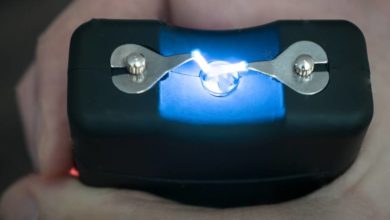Stun Gun vs. Taser: Which Is A Better Self-Defense Device for Women?
KEY TAKEAWAYS
An intriguing and supposedly groundbreaking less-lethal control weapon hit the law enforcement scene in the mid to late 1980s. It was a compact and lightweight electronic stun gun. It was advertised as being able to incapacitate violent, uncooperative suspects through the use of debilitating electric shocks.
However, it was only a short time before people realized that stun guns were ineffective and had a limited range. TASERs were created in the 1970s but were only used by law enforcement in the 1990s. Stun guns and TASERs are still available on the market.
What are the main distinctions between the two electroshock weapons, and how do you decide which is best for you? Read on to know more.
Stun Guns vs. Tasers: What Is The Difference
Self-defense is a serious discipline that has the potential to save your life. Only some people are at ease or physically capable of defending themselves exclusively with their hands and feet. This is where self-defense equipment comes in handy.
Most people initially think about owning firearms, yet having a gun for personal protection can cause many problems in terms of personal safety and security. Law enforcement officers have deployed electroshock devices, such as stun guns and tasers, to subdue an attacker less lethally.
Stun Guns
A stun gun uses electricity to stop an attacker. Several prongs are attached to the stun gun, which is pressed against the clothing or skin of a target. Once direct physical contact is made, the stun gun immediately delivers an electric shock that incapacitates the target.
The attacker may also experience temporary paralysis, loss of balance, extreme pain, and mental confusion, rendering him immobile for a few seconds.
Tasers
Like stun guns, taser devices use electric currents to immobilize an attacker and stop his movement. It is shaped like a traditional firearm, with a trigger and a barrel shape.
When you pull the trigger, the taser device shoots electric probes or darts at a distance of up to 15 feet, which are attached to the device with insulated wires. These probes can generally pass through clothing to deliver a 50,000-volt shock to a target.
The electric shock will affect the attacker’s muscles, causing immediate effects that include loss of muscle coordination, drowsiness, slurred speech, and loss of balance. It is also extremely painful, which causes attackers to fall to the ground.
Which Is Better For Self-Defense: Stun Guns Or Tasers
The primary distinctions between stun guns and tasers are range, reusability, and cost. TASERs are branded projectile weapons, while stun guns are inexpensive and require direct contact with the attacker.
Stun Gun vs. Taser: Range
Stun guns are close-proximity devices that require you to be in close contact with the person attacking you. They deploy a severe shock that could instantly incapacitate an attacker to deter further advancement.
On the other hand, a TASER fires a set of projectile prongs that attach to a target up to 15 feet away.
When a person pulls the trigger of their TASER device, the two prongs extend out, allowing them to attach to different body parts. This allows the TASER to send electricity across a larger area. While a TASER device is just as painful as a regular stun gun, it is more effective at incapacitating muscle functions, preventing an attacker from advancing.
Stun Gun vs. Taser: Reusability
Depending on the model, the projectile nature of a TASER renders its wires and probes ineffective after one or two rounds. Swapping out the TASER cartridge is simple yet time-consuming, severely limiting your options for preventing an attack. Not to mention, spare cartridges are costly.
On the other hand, most stun guns operate on a rechargeable battery and do not employ projectiles. You can use them as long as the battery has a charge. The only downside to this is the number of hours it takes to charge a stun gun device fully.
Stun Gun vs. Taser: Price
Most reliable stun guns, such as the Vipertek VTS-979, can be purchased for less than $25, unlike most TASER consumer-grade models, such as the TASER Pulse, which could cost $400 or more.
TASERs are also more expensive to operate, considering expenses like replacement cartridges, with the price ranging from $20 to $23, depending on whether you buy a 10-pack or a 2-pack. Similarly, replacement batteries may cost between $10 to $25, depending on the TASER device model.
Your budget is arguably the most important factor when purchasing a TASER device or a stun gun, but both offer distinct benefits and disadvantages. Women’s stun guns are less expensive and easy to reuse. However, a TASER allows you to defend yourself while maintaining a safe distance from the attacker.
If you wish to bring a self-defense device with you on your travels, read this article on whether or not tasers are allowed on planes by Security Forward.





